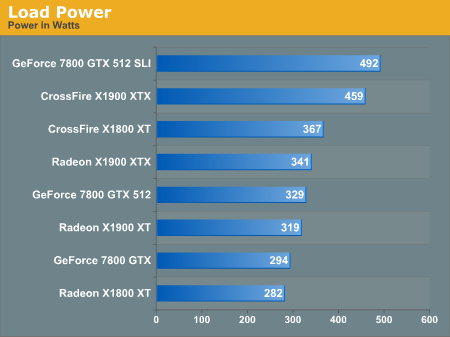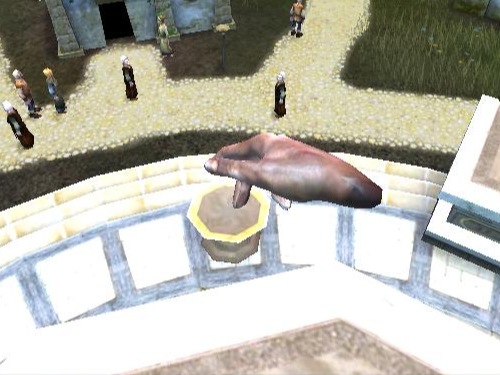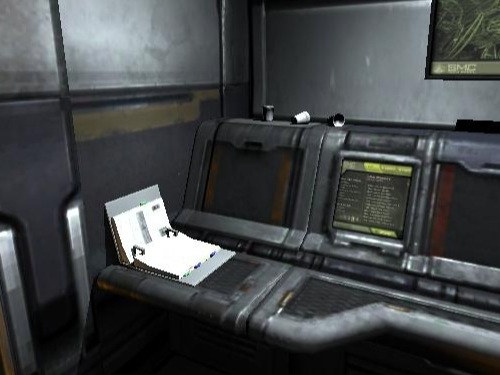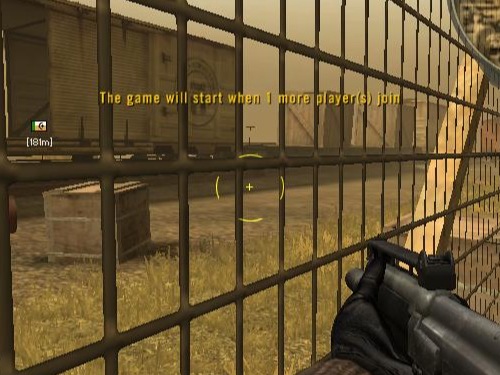ATI's New Leader in Graphics Performance: The Radeon X1900 Series
by Derek Wilson & Josh Venning on January 24, 2006 12:00 PM EST- Posted in
- GPUs
Image Quality, Feature Tests, and Power
Something we'd like to look at a bit more in-depth for this review is image quality. It's no secret that due to ATI and NVIDIA's differences in rendering graphics, there is always going to be some variation in the look of the graphics from one brand to another. Most times this variation is too subtle to notice, but upon closer inspection, certain patterns tend to emerge.
With Black and White 2, we can see how well the in-game maximum AA does at cleaning up the image. Note how there is a significant difference between the edges in the pictures without AA and with "high" AA enabled by the game. However, we don't see the same kind of difference between the image without AA enabled and the one with maximum quality enabled (in the graphics driver). This is a good example of in-game AA doing a much better job, quality and performance-wise, than the max quality settings in the control panel. We suspect that Black and White 2 has implimented a custom AA algorithm and has issues running stock MSAA algorithms. For this reason we recommend using the Black and White 2's in-game AA instead of the control panel's AA settings.
Both ATI and NVIDIA hardware look great and render similar images, and luckily for ATI there is an upcoming patch that should improve performance.
Battlefield 2 gives us a good view of how the maximum quality settings in the control panel (specifically transparency AA) fix certain graphical problems in games. Fences in particular have a tendency to render inaccurately, especially when looking through them at certain angles. While you can see that the in-game AA without adaptive or transparency AA cleans up a lot of jagged edges (the flag pole for instance), it still has trouble with parts of the fence.
As for power, we ran the multitexturing and pixel shader feature tests under 3dmark06 and measured the maximum powerload via our trusty Kill-A-Watt. This measures power at the wall before the PSU, so it doesn't focus only on the graphics cards.
We can see the CrossFire and SLI systems pull insane ammounts of power, but even as a single card the X1900 XTX is a very hungry part.

Something we'd like to look at a bit more in-depth for this review is image quality. It's no secret that due to ATI and NVIDIA's differences in rendering graphics, there is always going to be some variation in the look of the graphics from one brand to another. Most times this variation is too subtle to notice, but upon closer inspection, certain patterns tend to emerge.

Hold your mouse over the links below to see Image Quality (Right Click the links to download the full-resolution images):
| ATI | |||
| NVIDIA |
With Black and White 2, we can see how well the in-game maximum AA does at cleaning up the image. Note how there is a significant difference between the edges in the pictures without AA and with "high" AA enabled by the game. However, we don't see the same kind of difference between the image without AA enabled and the one with maximum quality enabled (in the graphics driver). This is a good example of in-game AA doing a much better job, quality and performance-wise, than the max quality settings in the control panel. We suspect that Black and White 2 has implimented a custom AA algorithm and has issues running stock MSAA algorithms. For this reason we recommend using the Black and White 2's in-game AA instead of the control panel's AA settings.
Both ATI and NVIDIA hardware look great and render similar images, and luckily for ATI there is an upcoming patch that should improve performance.

Hold your mouse over the links below to see Image Quality (Right Click the links to download the full-resolution images):

Hold your mouse over the links below to see Image Quality (Right Click the links to download the full-resolution images):
Battlefield 2 gives us a good view of how the maximum quality settings in the control panel (specifically transparency AA) fix certain graphical problems in games. Fences in particular have a tendency to render inaccurately, especially when looking through them at certain angles. While you can see that the in-game AA without adaptive or transparency AA cleans up a lot of jagged edges (the flag pole for instance), it still has trouble with parts of the fence.
As for power, we ran the multitexturing and pixel shader feature tests under 3dmark06 and measured the maximum powerload via our trusty Kill-A-Watt. This measures power at the wall before the PSU, so it doesn't focus only on the graphics cards.
We can see the CrossFire and SLI systems pull insane ammounts of power, but even as a single card the X1900 XTX is a very hungry part.











120 Comments
View All Comments
Harkonnen - Tuesday, January 24, 2006 - link
Almost $900 CDN for the XTX and it only has a 1 year warranty?Main reason I would never buy an expensive ATi card is that right there.
smitty3268 - Tuesday, January 24, 2006 - link
The people who buy a card this expensive the first day it comes out won't keep it for a whole year, so the warranty doesn't matter. In 6 months another card will be out that makes this one look slow and they'll be spending even more money.DerekWilson - Tuesday, January 24, 2006 - link
Due to popular demand, we have added more percent increase performance comparison graphs to the performance breakdown that shows the performance relatoinships at lower resolutions.Let us know if there is anything else you'd like to see. Thanks!
Live - Tuesday, January 24, 2006 - link
The performance breakdown looks very good now! I would go so far as to say that this should be standard in future reviews.piroroadkill - Tuesday, January 24, 2006 - link
Using a lossy image format (JPEG) for image quality comparison screenshots seems kind of... pointless.But I guess you have to worry about bandwidth.
Josh Venning - Tuesday, January 24, 2006 - link
Thanks for the input all. Just to let you know we are dealing with some problems regarding our power numbers, but they should be up shortly. Thanks for being patient.Josh Venning - Tuesday, January 24, 2006 - link
One more thing.. We also caught a mistype on the graphs that we are in the process of correcting. The two crossfire systems we tested are the X1900 XTX Crossfire and the X1800 XT Crossfire. (we miss-labeled the latter "X1900 XT Crossfire") Sorry for any confusion this may have caused.smitty3268 - Tuesday, January 24, 2006 - link
Ah... That makes much more sense now. I was wondering why the XTX crossfire was doing so much better than the XT crossfire when the specs were so similar.SpaceRanger - Tuesday, January 24, 2006 - link
Problems with the publishing of them, or problems in the sense that it requires a direct link into a nuclear reactor to power properly??
DerekWilson - Tuesday, January 24, 2006 - link
our local nuclear plant ran us an extention cord just for this event :-)